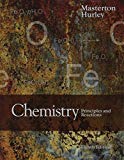
Bundle: Chemistry: Principles and Reactions, 8th, Loose-Leaf + OWLv2, 1 term (6 months) Printed Access Card
8th Edition
ISBN: 9781305717497
Author: William L. Masterton, Cecile N. Hurley
Publisher: Cengage Learning
expand_more
expand_more
format_list_bulleted
Question
Chapter 21, Problem 69QAP
Interpretation Introduction
Interpretation:
The reason for the yellow color of the concentrated nitric acid needs to be explained. The pure nitric acid is colorless.
Concept introduction:
The decomposition of concentrated
It results in the release of nitrogen dioxide and oxygen gas.
Expert Solution & Answer
Want to see the full answer?
Check out a sample textbook solution
Students have asked these similar questions
Determine if the following salt is neutral, acidic or basic. If acidic or basic, write the appropriate equilibrium equation for the acid or base that exists when the salt is dissolved in aqueous solution. If neutral, simply write only NR. Be sure to include the proper phases for all species within the reaction. NaN₃
Can I please get help with this?
Can I please get help with this?
Chapter 21 Solutions
Bundle: Chemistry: Principles and Reactions, 8th, Loose-Leaf + OWLv2, 1 term (6 months) Printed Access Card
Ch. 21 - Prob. 1QAPCh. 21 - Prob. 2QAPCh. 21 - Prob. 3QAPCh. 21 - Prob. 4QAPCh. 21 - Prob. 5QAPCh. 21 - Prob. 6QAPCh. 21 - Give the formula for the acidic oxide of (a) HNO3...Ch. 21 - Prob. 8QAPCh. 21 - Write the formulas of the following compounds. (a)...Ch. 21 - Prob. 10QAP
Ch. 21 - Prob. 11QAPCh. 21 - Prob. 12QAPCh. 21 - Prob. 13QAPCh. 21 - Prob. 14QAPCh. 21 - Prob. 15QAPCh. 21 - Prob. 16QAPCh. 21 - Prob. 17QAPCh. 21 - Write a balanced net ionic equation for the...Ch. 21 - Prob. 19QAPCh. 21 - Prob. 20QAPCh. 21 - Prob. 21QAPCh. 21 - Prob. 22QAPCh. 21 - Prob. 23QAPCh. 21 - Prob. 24QAPCh. 21 - Prob. 25QAPCh. 21 - Prob. 26QAPCh. 21 - Prob. 27QAPCh. 21 - Prob. 28QAPCh. 21 - Prob. 29QAPCh. 21 - Prob. 30QAPCh. 21 - Prob. 31QAPCh. 21 - Prob. 32QAPCh. 21 - Prob. 33QAPCh. 21 - Prob. 34QAPCh. 21 - The average concentration of bromine (as bromide)...Ch. 21 - Prob. 36QAPCh. 21 - Iodine can be prepared by allowing an aqueous...Ch. 21 - Prob. 38QAPCh. 21 - Prob. 39QAPCh. 21 - Prob. 40QAPCh. 21 - Prob. 41QAPCh. 21 - Prob. 42QAPCh. 21 - Prob. 43QAPCh. 21 - Prob. 44QAPCh. 21 - Prob. 45QAPCh. 21 - Given...Ch. 21 - What is the concentration of fluoride ion in a...Ch. 21 - Calculate the solubility in grams per 100 mL of...Ch. 21 - Prob. 49QAPCh. 21 - Follow the directions for Problem 49 for the...Ch. 21 - Consider the equilibrium system HF(aq)H+(aq)+F(aq)...Ch. 21 - Applying the tables in Appendix 1 to...Ch. 21 - Consider the reaction 4NH3(g)+5O2(g)4NO(g)+6H2O(g)...Ch. 21 - Data are given in Appendix 1 for white phosphorus,...Ch. 21 - Prob. 55QAPCh. 21 - Prob. 56QAPCh. 21 - Sodium hypochlorite is produced by the...Ch. 21 - Prob. 58QAPCh. 21 - Prob. 59QAPCh. 21 - Prob. 60QAPCh. 21 - Consider the reduction of nitrate ion in acidic...Ch. 21 - Prob. 62QAPCh. 21 - Choose the strongest acid from each group. (a)...Ch. 21 - Prob. 64QAPCh. 21 - Prob. 65QAPCh. 21 - Prob. 66QAPCh. 21 - Prob. 67QAPCh. 21 - Prob. 68QAPCh. 21 - Prob. 69QAPCh. 21 - Explain why (a) acid strength increases as the...Ch. 21 - Prob. 71QAPCh. 21 - Prob. 72QAPCh. 21 - The amount of sodium hypochlorite in a bleach...Ch. 21 - Prob. 74QAP
Knowledge Booster
Similar questions
- Use the Henderson-Hasselbalch equation to calculate pH of a buffer containing 0.050M benzoic acidand 0.150M sodium benzoate. The Ka of benzoic acid is 6.5 x 10-5arrow_forwardA. Draw the structure of each of the following alcohols. Then draw and name the product you would expect to produce by the oxidation of each. a. 4-Methyl-2-heptanol b. 3,4-Dimethyl-1-pentanol c. 4-Ethyl-2-heptanol d. 5,7-Dichloro-3-heptanolarrow_forwardWhat is the pH of a 1.0 L buffer made with 0.300 mol of HF (Ka = 6.8 × 10⁻⁴) and 0.200 mol of NaF to which 0.160 mol of NaOH were added?arrow_forward
- Can I please get help with this.arrow_forwardDetermine if the following salt is neutral, acidic or basic. If acidic or basic, write the appropriate equilibrium equation for the acid or base that exists when the salt is dissolved in aqueous solution. If neutral, simply write only NR. Be sure to include the proper phases for all species within the reaction. N₂H₅ClO₄arrow_forwardPlease help me with identifying these.arrow_forward
arrow_back_ios
SEE MORE QUESTIONS
arrow_forward_ios
Recommended textbooks for you
 Chemistry: Principles and ReactionsChemistryISBN:9781305079373Author:William L. Masterton, Cecile N. HurleyPublisher:Cengage Learning
Chemistry: Principles and ReactionsChemistryISBN:9781305079373Author:William L. Masterton, Cecile N. HurleyPublisher:Cengage Learning ChemistryChemistryISBN:9781305957404Author:Steven S. Zumdahl, Susan A. Zumdahl, Donald J. DeCostePublisher:Cengage Learning
ChemistryChemistryISBN:9781305957404Author:Steven S. Zumdahl, Susan A. Zumdahl, Donald J. DeCostePublisher:Cengage Learning Chemistry: An Atoms First ApproachChemistryISBN:9781305079243Author:Steven S. Zumdahl, Susan A. ZumdahlPublisher:Cengage Learning
Chemistry: An Atoms First ApproachChemistryISBN:9781305079243Author:Steven S. Zumdahl, Susan A. ZumdahlPublisher:Cengage Learning
 Chemistry & Chemical ReactivityChemistryISBN:9781337399074Author:John C. Kotz, Paul M. Treichel, John Townsend, David TreichelPublisher:Cengage Learning
Chemistry & Chemical ReactivityChemistryISBN:9781337399074Author:John C. Kotz, Paul M. Treichel, John Townsend, David TreichelPublisher:Cengage Learning Chemistry: The Molecular ScienceChemistryISBN:9781285199047Author:John W. Moore, Conrad L. StanitskiPublisher:Cengage Learning
Chemistry: The Molecular ScienceChemistryISBN:9781285199047Author:John W. Moore, Conrad L. StanitskiPublisher:Cengage Learning

Chemistry: Principles and Reactions
Chemistry
ISBN:9781305079373
Author:William L. Masterton, Cecile N. Hurley
Publisher:Cengage Learning

Chemistry
Chemistry
ISBN:9781305957404
Author:Steven S. Zumdahl, Susan A. Zumdahl, Donald J. DeCoste
Publisher:Cengage Learning

Chemistry: An Atoms First Approach
Chemistry
ISBN:9781305079243
Author:Steven S. Zumdahl, Susan A. Zumdahl
Publisher:Cengage Learning


Chemistry & Chemical Reactivity
Chemistry
ISBN:9781337399074
Author:John C. Kotz, Paul M. Treichel, John Townsend, David Treichel
Publisher:Cengage Learning

Chemistry: The Molecular Science
Chemistry
ISBN:9781285199047
Author:John W. Moore, Conrad L. Stanitski
Publisher:Cengage Learning